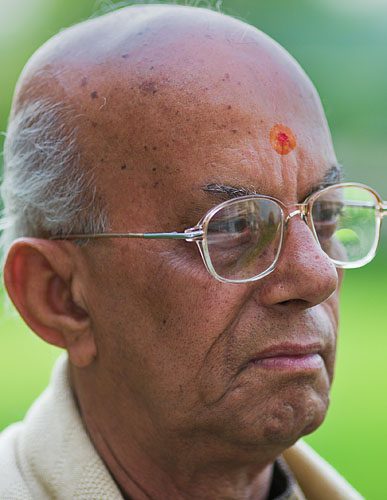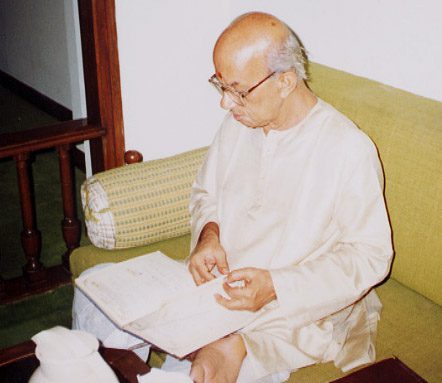A version of this tribute was published on the occasion of Ramrang’s 75th birthday felicitation event held in New Delhi on August 16, 2003
[Update: Pandit Ramashreya Jha “Ramrang” passed away on January 1, 2009. He was 80.]
Namashkar.
Today we gather under one roof to honour Ramashreya Jha “Ramrang” and to reflect on the oeuvre of this rara avis who dedicated his life to realising the highest ideals that illumine the musical pathways of our land. We celebrate this apostle who, through years of ardent study and contemplation, deepened our understanding of raga and clarified its foundations in both shastra and performance.
For sixty years, Ramashreya Jha applied his critical and creative faculties, coursed through the demesne of his formidable intellect, and retrieved melodic artefacts of enduring value – only to replant them in the garden of our imagination. In doing so, Ramrang made our world more beautiful, and more meaningful.
It is now our turn to punctuate his musical odyssey with a collective offering of gratitude, affection, and admiration.

Ramashreya Jha “Ramrang”
(© Rajan P. Parrikar)
To think of Ramrang is to think of his fanatical love of learning, the unusual depth and breadth of his knowledge, his high standards of excellence, his remarkable ingenuity, and above all, the passion and joie de vivre with which he disburses the fruits of his endeavours. A sharp focus in life is a benediction granted to only the most fortunate among us. Music has been the sole and defining hinge around which Ramrang‘s life has revolved. It has been his raison d’être, his anodyne, and his refuge from “the crowded trivialities of everyday life,” to borrow the phrase from Rabindranath Thakur. The extent of this monomania is suggested by his own occasional utterance: aur kuchh na aataa hai na kartaa hoon.
Sangeetacharya Ramashreya Jha “Ramrang” was born on August 11, 1928, in Darbhanga, in the Mithila region of Bihar, once a flourishing centre of dhrupad music. His father, Sukhdev Jha, and his uncle, Madhusudan Jha, were his earliest mentors. But his final calling was nurtured and shaped during the twenty-five years he spent in Allahabad, at the ashram of his distinguished guru, Bholanath Bhatt. Allahabad was to remain his karmabhoomi.
Ramrang also benefited from the guidance of other vidwans, including B.N. Thakar of Allahabad and Habib Khan of Kirana. Some fifteen years of his youth were spent with a drama company in Varanasi, an experience that broadened his musical horizons and attuned him to the rustic antecedents of our Art music.
In 1968, he was appointed to the faculty of Allahabad University, and in 1980, elevated to Head of the Music Department. This singular move by the University was a recognition of genuine merit, for Ramrang held no formal degrees. He retired from active professorial duty in 1989.
Ramrang’s composite musical personality unravels into four interrelated strands that are briefly touched upon:

Ramashreya Jha “Ramrang” in Goa (1999)
(a) He is a shastrakara of the highest order, and the fruits of his lifelong meditations on the nature of raga are embodied in the five published volumes of Abhinava Geetanjali. These classics mark a signal contribution to Indian music. They dazzle with the keenness of their author’s intellect, and reveal his vast knowledge, mental agility, and depth of scholarship. The volumes display a rare gift for formulating and conveying ideas with elegance and clarity. Their insights and critical analyses of ragas, along with the hundreds of high-quality compositions by Ramrang that they contain, compel the inescapable conclusion: Ramashreya Jha “Ramrang” is the Bhatkhande of our time.
(b) As a preeminent vaggeyakara, Ramrang‘s fertile imagination, remarkable retentiveness, and quickness of mind form the core strengths that animate his creative impulse. He carries within him the full compass of essential music, ever at hand for instant recall. A high-quality bandish must encapsulate the lakshanas – the melodic essence – of a raga. A typical Ramrang composition goes farther: every word, swara, and matra is bound in a symbiotic melodic structure that achieves an aesthetic unity rarely encountered in the run-of-the-mill traditional bandish.
His compositions place him squarely among the handful of supremely gifted musical minds in any generation to whom the mantra of music is vouchsafed. Among the earliest musicians to recognise Jha-sahab’s erudition and fall under the spell of his work was Jitendra Abhisheki, who sang, popularised, and taught many of Ramrang’s bandishes. These compositions would later enter the repertoire of several leading vocalists.

(c) As a performer, Ramrang‘s gayaki is best appreciated by those attuned to the nuances of swara and raga. One does not turn to Ramrang for vocal acrobatics or high-velocity taans – indeed, he engages in neither – but to drink from the wellspring of raganubhava. His is a lakshana-oriented approach. Even the familiar, much-travelled ragas, when refracted through Ramrang’s mental prism, acquire a distinct conceptual body and flavour.
Unlike most Hindustani renditions of the present day, Ramrang does not make short shrift of the bandish text. On the contrary, with his acute sense of the poetic and the dramatic, he recalls the values intrinsic to the older dhrupad genre, marrying verse and swara with such felicity that the two seem inseparable.
Ramrang’s creative acumen lies not only in his superbly conceived compositions but also in his manner of uccharana, which accompanies the unfolding of the raga edifice – what practitioners call asthaai bharnaa – from the skeletal bandish.

(d) Ramrang’s final facet concerns his role as an educator. Over the years, he has trained and guided several students. His senior disciple, Dr Geeta Banerjee, an eminent author, scholar, and musician, later succeeded him as Head of the Music Department at Allahabad University. Another pupil, Shubha Mudgal, has earned international recognition.
This website offers numerous examples of Ramrang’s gifts as an expositor and the inspirited delivery he brings to that task. His discourses have come to be cherished both as pedagogic masterpieces and as vignettes of aesthetic delight.
(Update: In 2005, the President of India conferred upon him the Sangeet Natak Akademi Award for his contributions to music.)
Today, as he has done for the past six decades, Ramrang spends his waking hours immersed in the contemplation and creation of music. True to his calling, his intellectual wanderlust shows no sign of abating; each day yields a new insight or a newly minted asthai. In this context, we are reminded of Einstein’s remark: “Only in Science and Art are we permitted to remain children all our lives.”
Ramrang has spent most of his musical life in relative isolation, removed from the glare of public adulation and on the margins of the community of active performing musicians. This is entirely in keeping with his temperament and his inner conviction that music is a lifelong sadhana, a discipline that demands self-restraint and unwavering focus.
In summing up the musical life of Ramashreya Jha “Ramrang,” one is reminded of the understated flourish of Professor G. H. Hardy: “Whatever we do may be small, but it has a certain character of permanence; and to have produced anything of the slightest permanent interest… is to have done something utterly beyond the powers of the vast majority of men” (A Mathematician’s Apology).
